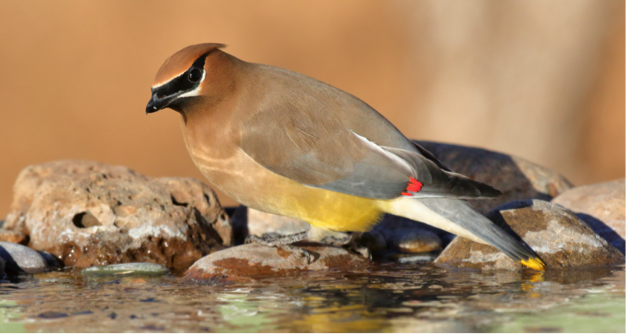By Bob Walker
This has been a great spring for seeing Cedar Waxwings (Bombycilla cedrorum). These very attractive birds have been reported in White Rock, in Los Alamos, and at the Los Alamos Nature Center, often in the company of American Robins. They are medium-sized birds, a bit smaller than a Robin, with a distinctive black mask, head crest, pale yellow lower belly, bright yellow tips on their tail feathers, and bright red wax-like tips on their secondary wing feathers. Males and females are very similar; males tend to have a little more black coloration in their throats, and slightly longer and more numerous red waxy wing tips.
Cedar Waxwings feed largely on fruits and berries, but will also catch insects on the fly, much like swallows do. In our area, I have seen Waxwings enjoying berries on female juniper bushes, and flocking in large numbers in Russian olive trees. The Russian olive tree one house away from me has been stripped of all its olives in the last three weeks. The seeds they eat pass completely through their digestive tracts, making them unusual in the bird-world, since most fruit-eating birds regurgitate the seeds they ingest.
These migratory birds spend their summers breeding in northern North America and southern Canada before traveling southwards for the winter months. Once they reach their destinations, they then wander about, following available food sources. Food availability is one reason why we may be seeing so many now; they may be exploiting food reserves here, fattening up before they leave in another month or so. Cedar Waxwings are one of the species of birds whose numbers are increasing, due presumably to interactions with humans, because they thrive on the bushes and trees that humans have planted in suburban environments.
The trained ear can pick out the high-pitched, thin calls of the Cedar Waxwings.
They call both while perching in trees, and also while flying.
Find more detailed articles about the Cedar Waxwing on these web pages: identify.whatbird.com and allaboutbirds.org
Enjoy more beautiful photos of Cedar Waxwings at the Glenn Bartley and Robert Royse web sites.

